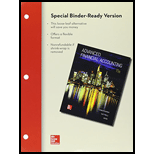
a.
To prepare:
Introduction: Internal expansion refers to situation in a company forms a subsidiary by transferring some of its assets and liabilities and in exchange of ownership shares. Shares of the subsidiary is either provided to the shareholders in addition to their existing shares (Spin off) or in exchange of their existing shares (split off).
a.
Explanation of Solution
In the books of parent company:
Record transfer of assets and liabilities:
| Date | Account | Debit ($) | Credit($) |
| Investment in Subsidiary M common stock | 498,000 | ||
| Provision for doubtful debts | 7,000 | ||
| 35,000 | |||
| Accumulated depreciation- Equipment | 60,000 | ||
| Cash | 40,000 | ||
| | 75,000 | ||
| Inventory | 50,000 | ||
| Land | 35,000 | ||
| Building | 160,000 | ||
| Equipment | 240,000 | ||
| (To record formation of subsidiary.) |
Table (1)
- Investment in Subsidiary M common stock is an asset and it is increased by $498,000. Therefore, Investment in Subsidiary M common stock account is debited with $498,000.
- Provision for doubtful debts is a contra asset and it is decreased by $7,000. Therefore, Provision for doubtful debts account is debited with $7,000.
- Accumulated depreciation-Building is a contra asset and it is decreased by $35,000. Therefore, Accumulated depreciation- Buildings account is debited with $35,000.
- Accumulated depreciation-Equipment is a contra asset and it is decreased by $60,000. Therefore, Accumulated depreciation- Equipment account is debited with $60,000.
- Cash is an asset and it is decreased by $40,000. Therefore, cash account is credited with $40,000.
- Accounts Receivable is an asset and it is decreased by $75,000. Therefore, Accounts Receivable account is credited with $75,000.
- Inventory is an asset and it is decreased by $50,000. Therefore, Inventory account is credited with $50,000.
- Land is an asset and it is decreased by $35,000. Therefore, Land account is credited with $35,000.
- Building is an asset and it is decreased by $160,000. Therefore, account is credited with $160,000.
- Equipment is an asset and it is decreased by $240,000. Therefore, account is credited with $240,000.
b.
To prepare: Journal entries that subsidiary company would record.
Introduction: Internal expansion refers to situation in a company forms a subsidiary by transferring some of its assets and liabilities and in exchange of ownership shares. Shares of the subsidiary is either provided to the shareholders in addition to their existing shares (Spin off) or in exchange of their existing shares (split off).
b.
Explanation of Solution
In the books of subsidiary company:
Record transfer of assets and liabilities:
| Date | Account | Debit ($) | Credit($) |
| Cash | 40,000 | ||
| Accounts Receivable | 75,000 | ||
| Inventory | 50,000 | ||
| Land | 35,000 | ||
| Buildings | 160,000 | ||
| Equipment | 240,000 | ||
| Provision for doubtful debts | 7,000 | ||
| Accumulated | 35,000 | ||
| Accumulated depreciation- Equipment | 60,000 | ||
| Common Stock, $3 par | 120,000 | ||
| Additional paid in capital (balancing figure) | 378,000 | ||
| (To record receipt of assets and liabilities and issuance of stock.) |
Table (2)
- Cash is an asset and it is increased by $40,000. Therefore, cash account is debited with $40,000.
- Accounts Receivable is an asset and it is increased by $75,000. Therefore, Accounts Receivable account is debited with $75,000.
- Inventory is an asset and it is increased by $50,000. Therefore, Inventory account is debited with $50,000.
- Land is an asset and it is increased by $35,000. Therefore, Land account is debited with $35,000.
- Building is an asset and it is increased by $160,000. Therefore, Buildings account is debited with $160,000.
- Equipment is an asset and it is increased by $240,000. Therefore, Equipment account is debited with $240,000.
- Provision for doubtful debts is a contra asset and it is increased by $7,000. Therefore, Provision for doubtful debts account is credited with $7,000.
- Accumulated depreciation-Building is a contra asset and it is increased by $35,000. Therefore, Accumulated depreciation- Buildings account is credited with $35,000.
- Accumulated depreciation- Equipment is a contra asset and it is increased by $60,000. Therefore, Accumulated depreciation- Equipment account is credited with $60,000.
- Common Stock is equity and it is increased by $120,000. Therefore, Common Stock account is credited with $120,000.
- Additional paid in capital is equity and it is increased by $378,000. Therefore, Additional paid in capital account is credited with $378,000.
Want to see more full solutions like this?
Chapter 1 Solutions
LOOSE-LEAF Advanced Financial Accounting with Connect
- How do milestone payments affect contract revenue recognition? a) Accrue when milestone achieved b) Recognize at contract completion c) Record when cash received d) Spread evenly over contract. MCQarrow_forwardWhat is the interest expense for December 31 ?arrow_forwardWhat is the amount of income or loss from acceptance of the offer ?arrow_forward

